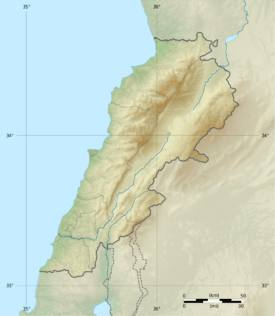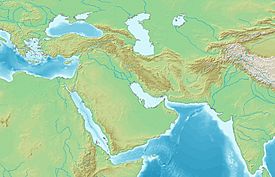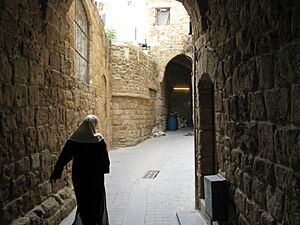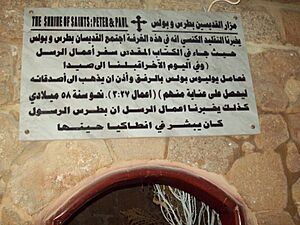Sidon facts for kids
Quick facts for kids
Sidon
صيدا
|
|
|---|---|
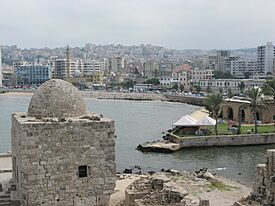
Sidon's Sea Castle
|
|
| Country | Lebanon |
| Governorate | South Governorate |
| District | Sidon District |
| Settled | 3rd millennium BC |
| Area | |
| • City | 3.02 sq mi (7.82 km2) |
| • Metro | 10 sq mi (25 km2) |
| Population | |
| • City | ~80,000 |
| • Metro | ~266,000 |
| Time zone | UTC+2 (EET) |
| • Summer (DST) | UTC+3 (EEST) |
| Area code(s) | 07 |
Sidon (/ˈsaɪdən/ SY-dən), also known as Saida (/ˈsaɪdə, ˈsɑːɪdə/ SY-də-,_-sah-ID-ə; Arabic: صيدا, romanized: Ṣaydā), is the third-largest city in Lebanon. It sits right on the Mediterranean coast. Sidon is the capital of the South Governorate. It is about 40 kilometres (25 miles) from Tyre to the south and Beirut, Lebanon's capital, to the north. About 80,000 people live in Sidon, and over 250,000 live in its wider metropolitan area.
Contents
What's in a Name?
The ancient Phoenician name for the city was Ṣīdūn (𐤑𐤃𐤍). This name likely meant "fishery" or "fishing town." It was called ḏjdwnꜣ in ancient Egyptian texts. In the Hebrew Bible, it's Ṣīḏōn (Hebrew: צִידוֹן). The ancient Greeks called it Sidṓn (Ancient Greek: Σιδών), and the Romans later used the name Sidon.
In Classical Arabic, it was Ṣaydūn (صَيْدونْ), and today in Modern Arabic, it is Ṣaydā (صَيْدَا). When it was a Roman colony, it was given the fancy name Colonia Aurelia Pia Sidon. This was to honor its powerful Roman sponsor. In the Book of Genesis, Sidon is mentioned as the first son of Canaan. During the crusades, Sidon was known by names like Sagittus in Latin and Saete in Old French.
Sidon's Long History
Sidon has a very long history, going back thousands of years. It was a very important Phoenician city. It was built on a piece of land sticking out into the sea and had two harbors. Many different empires conquered Sidon over time. These included the Assyrians, Babylonians, Egyptians, Persians, Greeks, and finally the Romans.
Under Persian rule, Sidon became even more important than Tyre. In the New Testament, Herod the Great, Jesus, and Saint Paul are all said to have visited Sidon. Later, the city was taken over by the Arabs and then by the Ottoman Turks.
Early Beginnings
People have lived in Sidon since very ancient times. Archaeologists have found stone tools from the Acheulean period (a very early Stone Age time). They also found tools from a time just before pottery was invented.
Bronze Age Power
Around 1350 BC, Sidon was part of the Egyptian Empire. During this time, there was a lot of fighting between cities along the Lebanese coast. Sidon was a strong city-state. The oldest known words written in the Phoenician language of Sidon are from this period.
Iron Age and Phoenician Trade

Sidon was one of the most important Phoenician cities, and it might have been the oldest. From Sidon and other ports, the Phoenicians built a huge trading empire across the Mediterranean Sea. The ancient Greek poet Homer praised Sidon's skilled workers who made glass and purple dyes. He also admired the embroidery skills of its women.
Sidon was famous for two main industries: making glass and producing purple dye. The purple dye was made from Murex trunculus shells. This dye was so rare and special that it became a symbol of royalty.
In 1855, the sarcophagus (a stone coffin) of King Eshmun’azar II was found. An inscription on it showed he was a "king of the Sidonians" around the 5th century BC. It also mentioned the gods Eshmun and Ba‘al Sidon as the main gods of the Sidonians. Sidon's navy was important in the Battle of Salamis in 480 BC, fighting with the Persian fleet against the Greeks.
Persian and Greek Times
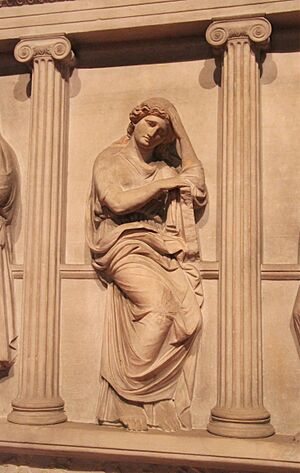
Like other Phoenician cities, Sidon was conquered many times. First, by the Achaemenid Empire (Persians) in the 6th century BC. Then, Alexander the Great took over in 333 BC, starting the Hellenistic period. Persian culture had a big impact, changing the city's building styles.
Under Alexander's successors, Sidon had some freedom. It even held games and competitions where top athletes from the region competed. Important tombs were found in Sidon's Greek-style burial ground (necropolis). These include the famous Alexander Sarcophagus and the Sarcophagus of the Crying Women. These are now in the Archaeological Museum in Istanbul.
Roman Rule
When Sidon became part of the Roman Empire, it still made its own silver coins. Herod the Great, king of Judaea, built a theater there. The Romans also built other big buildings and an underground temple called a Mithraeum. Sidon remained a quiet town until the Muslim conquest of the Levant in 636 AD.
Crusader and Ayyubid Periods
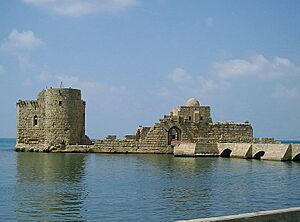
On December 4, 1110, Sidon was captured by Baldwin I of Jerusalem and Sigurd I of Norway after a siege. It became an important Crusader area called the Lordship of Sidon. Saladin took it from the Crusaders in 1187, but German Crusaders helped get it back in 1197. Sidon was an important Crusader stronghold until it was destroyed by the Ayyubids in 1249. In 1260, the Mongols destroyed it again. You can still see parts of the old walls today.
Ottoman Empire Era
Sidon became part of the Ottoman Turkish rule in the early 1500s. It became the capital of the Sidon province and became important for trade again. In the 18th century, the Hammud family controlled the city. They were in charge of cotton production and export. They built many palaces and public buildings in Sidon.
In 1840, during a war between Egypt and the Ottomans, British Admiral Charles Napier bombarded Sidon. The city surrendered in two days.
In the 19th century, the Jewish community in Sidon grew. They built a new synagogue in 1860. By 1900, Sidon was a small fishing town with about 10,000 people.
After World War I
After World War I, Sidon became part of the French Mandate of Lebanon. During World War II, British forces captured the city. After the war, Sidon became a major city in independent Lebanon.
After the 1948 conflict, many Palestinian refugees came to Sidon. They settled in large refugee camps like Ein el-Hilweh and Mieh Mieh. These camps became like neighborhoods of Sidon.
In 1982, the Israeli army occupied Sidon for about two and a half years. In 1997, there was shelling in Sidon that killed civilians.
By 2000, Sidon had a population of 65,000 in the city and about 200,000 in the wider area. The flat land around the city is used to grow wheat, vegetables, and fruits like citrus and bananas. Fishing is still important, with a new fishery that sells fresh fish every morning. The old harbor is now a fishing port.
The Saida Municipal Stadium opened in 2000 for a big football tournament.
Cleaning Up Sidon
Near the southern entrance to Sidon, there used to be a huge pile of rubbish called the Makab. It was like a four-story building made of waste. This dump was a big problem for the environment and people's health.
In 2004, an engineer named Hamzi Moghrabi came up with a plan to fix the waste problem. A treatment plant started working in 2013. There are also plans to clean up the whole area and turn the dump into a green space. The goal is to make Sidon's beaches beautiful again and attract tourists.
Who Lives in Sidon?
Most people in Sidon are Sunni Muslim. There are also smaller groups of Shia Muslims and Christians. Sidon is an important religious center for both Sunni and Shia Muslims, and for Greek Melkite Catholics.
In the 1930s, Sidon had the largest Jewish population in Lebanon.
| Religion | Voters | Percent (%) | Religion | Voters | Percent (%) |
|---|---|---|---|---|---|
| Sunni Muslim | 36163 | 79.7 | Sunni Islam | ||
| Shia Muslim | 4888 | 10.8 | Shia Islam | 82 | 0.2 |
| Armenian Catholic | 38 | 0.1 | Armenian Catholic | ||
| Druze | 43 | 0.1 | Chaldean Catholic | 19 | 0.0 |
| Alawite | 2 | 0.0 | Syriac Orthodox | 18 | 0.0 |
| Greek Melkite Catholic | 1686 | 3.7 | Syriac Catholic | 17 | 0.0 |
| Maronite | 1513 | 3.3 | Assyrian Church of the East | 4 | 0.0 |
| Greek Orthodox | 310 | 0.7 | Coptic | 1 | 0.0 |
| Armenian Orthodox | 256 | 0.6 | Other Christians | 19 | 0.0 |
| Evangelicals | 171 | 0.4 | Unspecified | 161 | 0.4 |
Places to See in Sidon
- Sidon Sea Castle: This is a fortress built by the Crusaders in the early 13th century. It's right by the Port of Sidon.
- Sidon Soap Museum: Here, you can learn about how soap was made in the region and see the different steps.
- Khan al-Franj ("Caravanserai of the French"): This old building complex was built in the 16th century. It was used by French merchants to trade goods with Europe. It has a big rectangular courtyard and a fountain.
- Debbane Palace: A historic home built in 1721, showing beautiful Arab-Ottoman architecture. It is being turned into the History Museum of Sidon.
- The Castle of St. Louis (Qalaat Al Muizz): Built by the Crusaders in the 13th century on top of an older fortress. It's south of the Old Souks.
- Eshmun Temple: This temple was built in the 7th century BC and was dedicated to Eshmun, the Phoenician god of healing. It's north of Sidon near the Awali river.
- The British War Cemetery: Opened in 1943, this cemetery is where soldiers who died during World War II are buried. It's a well-kept garden.
Learning in Sidon
Sidon has many schools and universities. In 2006, there were 29 schools with over 18,000 students. About 37% of students were in public schools, and 63% were in private schools. Sidon also has 10 universities, with 5 of them being private.
| University | Faculty | Type |
|---|---|---|
| Lebanese International University (LIU) | N/A | Private |
| Lebanese University (LU) | Faculty of Law, Political Science and Public Administration | Public |
| Saint Joseph University (USJ) | N/A | Private |
| American University of Lebanon (AUL) | N/A | Private |
| Al-Jinan University | N/A | Private |
| Lebanese University (LU) | Faculty of Public Health | Public |
| Lebanese University (LU) | Faculty of Literature and human Science | Public |
| Lebanese University (LU) | Institute of Social Sciences | Public |
| American University of Science and Technology | N/A | Private |
| Lebanese American University | N/A | Private |
| Lebanese University (LU) | Institute of Technology | Public |
Discovering Ancient Sidon
Archaeologists have found many ancient sites around Sidon, showing that people lived here from the very earliest times.
Sidon I is an archaeological site east of the city where flint tools from 3800 to 3200 BC were found. Sidon II is another site where tools from the Acheulean period were discovered. Sidon III has large flint tools that might be from the Heavy Neolithic period. Sidon IV is the ancient mound of Sidon, now under the ruined Saint Louis Castle. It has remains from the Early Bronze Age (around 3200 BC).
Bronze Age Discoveries
Recent digs have found a settlement from the Early Bronze Age I on solid rock. This shows continuous life from the Early Bronze Age to the Middle Bronze Age. Not much was known about Sidon during the Middle Bronze Age until recently.
Since the early 2000s, excavations at Tell el-Burak, 9 km south of Sidon, have helped a lot. This site was active during the Middle Bronze Age and is well preserved. It seems Sidon was a major power center during this time, controlling a large area.
Digging Up the Past
Many important ancient burial grounds (necropoli) have been found around Sidon. Famous archaeologists like Ernest Renan explored these sites in the 19th century. His findings were published in his book, Mission de Phénicie.
The grounds of the Saint Louis Castle were excavated by a French team from 1914 to 1920. In 1998, the British Museum started new excavations in the area. Many important finds from Sidon are now displayed in the National Museum of Beirut.
Sidon in the Bible
Old Testament Mentions
The Hebrew Bible talks about Sidon many times:
- It was named after the first son of Canaan, who was Noah's grandson (Genesis 10:15, 19).
- It was the first home of the Phoenicians on the coast and became a "great" city because of its trade (Joshua 11:8, 19:28).
- Sidon was the "mother city" of Tyre.
- The Sidonians often troubled Israel (Judges 10:12).
- Solomon married Sidonian women, which brought their worship into land of Israel (1 Kings 11:1, 33).
- Jezebel was the daughter of King Ithobaal I of Sidon (1 Kings 16:31).
- Sidon was known for its crafts and trade (1 Kings 5:6; 1 Chronicles 22:4; Ezekiel 27:8).
- The prophet Elijah stayed in Sidon and performed miracles there (1 Kings 17:9–24; also in the New Testament, Luke 4:26).
New Testament Mentions
- Jesus visited the areas near Tyre and Sidon (Matthew 15:21; Mark 7:24). Many people from this region came to hear him preach (Mark 3:8; Luke 6:17).
- From Sidon, where his ship stopped after leaving Caesarea, Paul sailed to Rome (Acts 27:3, 4).
Gallery
Famous People from Sidon
From Ancient Times
- Eumaeus: A character from Greek mythology. In Homer's stories, he was kidnapped as a child from Sidon, where his father was king.
- Antipater of Sidon (2nd century BC): A poet.
- Zeno of Sidon (c. 150 – c. 75 BC): A philosopher born in Sidon.
- Dorotheus of Sidon (1st century BC): A Greek astrologer.
- Boethus of Sidon (c. 75 – c. 10 BC): A philosopher.
- Tiberius Julius Abdes Pantera: A Roman soldier born in Sidon.
- Zenobius and his sister Zenobia: Early Christian martyrs.
From Modern Times
- Fayza Ahmed: A famous Arab singer.
- Raymond Audi: An international banker and former government minister.
- Bahia Hariri: A former Minister of Education and a philanthropist (someone who helps others).
- Rafic Hariri: A former Prime Minister of Lebanon and a successful businessman.
- Saad Hariri: Also a former Prime Minister of Lebanon.
- Adel Osseiran: One of the people who helped create modern Lebanon. He was a Speaker of the Lebanese Parliament.
- Fouad Siniora: A former Prime Minister of Lebanon.
- Riad Solh: A former Prime Minister of Lebanon.
See also
 In Spanish: Sidón para niños
In Spanish: Sidón para niños


